Related Research Articles

The Mazda MX-5 is a lightweight two-passenger roadster manufactured and marketed by Mazda with a front mid-engine, rear-wheel-drive layout. The convertible is marketed as the Mazda Roadster or Eunos Roadster in Japan, and as the Mazda MX-5 Miata in North America, where it is widely known as the Miata.

A sports car is designed to emphasise handling, performance, or thrill of driving. Sports cars originated in Europe in the early 1900s and are currently produced by many manufacturers around the world.
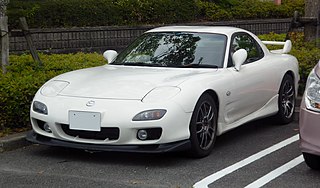
The Mazda RX-7 is a front/mid-engine, rear-wheel-drive, rotary engine-powered sports car that was manufactured and marketed by Mazda from 1978 to 2002 across three generations, all of which made use of a compact, lightweight Wankel rotary engine.

The Mazda RX-8 is a sports car manufactured by Japanese automobile manufacturer Mazda between 2002 and 2012. It was first shown in 2001 at the North American International Auto Show. It is the successor to the RX-7 and, like its predecessors in the RX range, it is powered by a rotary Wankel engine. The RX-8 was available for sale in North America from the 2003 model year.

The Mazda Cosmo is an automobile which was produced by Mazda from 1967 to 1995. Throughout its history, the Cosmo served as a "halo" vehicle for Mazda, with the first Cosmo successfully launching the Mazda Wankel engine. The final generation of Cosmo served as Mazda's flagship vehicle in Japan, being sold as the Eunos Cosmo through its luxury Eunos division in Japan.
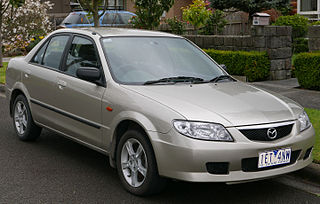
The Mazda Familia, also marketed prominently as the Mazda 323 and Mazda Protegé, is a small family car that was manufactured by Mazda between 1963 and 2003. The Familia line was replaced by the Mazda3/Axela for 2004.
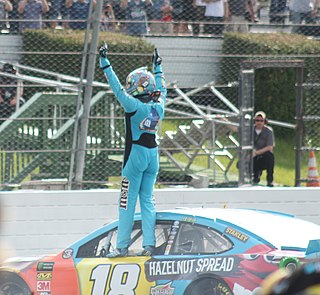
Toyota Racing Development is the in-house tuning shop for all Toyota, Lexus and formerly Scion cars. TRD is responsible both for improving street cars for more performance and supporting Toyota's racing interests around the world. TRD produces various tuning products and accessories, including performance suspension components, superchargers, and wheels. TRD parts are available through Toyota dealers, and are also available as accessories on brand-new Toyotas and Scions. Performance parts for Lexus vehicles are now labeled as F-Sport and performance Lexus models are labeled F to distinguish Lexus's F division from TRD.
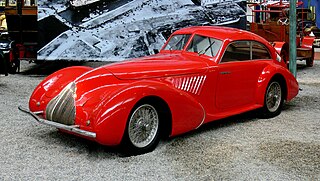
The Alfa Romeo 8C was originally a range of Alfa Romeo road, race and sports cars of the 1930s. In 2004 Alfa Romeo revived the 8C name for a V8-engined concept car which made it into production for 2007, the 8C Competizione.

The Mazda CX-7 is a mid-size crossover SUV from Mazda, and is the production version of the MX-Crossport concept car. It was shown publicly for the first time at the 2006 LA Auto Show in January. Production officially began on February 20, 2006 in Mazda's Ujina #2 factory in Hiroshima, and went on sale in April 2006 as a model for 2007. The CX-7 was Mazda's first mid-size SUV, since the Navajo was discontinued in 1994.

The Bentley 3 Litre was a car chassis manufactured by Bentley. The company's first it was developed from 1919 and made available to customers' coachbuilders from 1921 to 1929. The Bentley was very much larger than the 1368 cc Bugattis that dominated racing at the time, but double the size of engine and strength compensated for the extra weight. The 4000 lb (1800 kg) car won the 24 Hours of Le Mans in 1924, with drivers John Duff and Frank Clement, and again in 1927, this time in Super Sports form, with drivers S. C. H. "Sammy" Davis and Dudley Benjafield. Its weight, size, and speed prompted Ettore Bugatti to call it "the fastest lorry in the world." This was regarded as a compliment and the inbuilt ruggedness of the design has proven this over 100+ years! Built in 3 main variants, Blue label, Red Label Speed models all carrying a 5-year warranty, and the coveted and rare Green Label 100 mph cars, which only carried a 12-month warranty reflecting the high state of tune.

The Bentley 4½ Litre was a British car based on a rolling chassis built by Bentley Motors. Walter Owen Bentley replaced the Bentley 3 Litre with a more powerful car by increasing its engine displacement to 4.4 litres. A racing variant was known as the Blower Bentley.
The Vision Gran Turismo program is a series of fictional concept cars for the Gran Turismo video game series, developed by a cross-section of the world's top automobile manufacturers. These vehicles appeared originally in the video games Gran Turismo 6, and later in Gran Turismo Sport, both from Polyphony Digital. For the most part, they apply present-day technology and materials, with two notable exceptions that utilize novel propulsion and aerodynamic technologies. Their appearance as free in-game cars has been staggered since the launch of GT6 in 2013, with each one being available for download upon release.
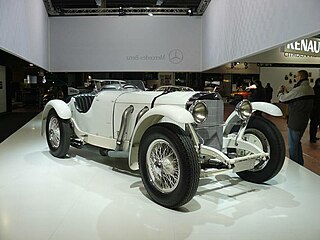
The Mercedes-Benz SSK (W06) is a roadster built by German automobile manufacturer Mercedes-Benz between 1928 and 1932. The name is an abbreviation of Super Sport Kurz, German for "Super Sport Short", as it was a short wheelbase development of the Mercedes-Benz Modell S. The SSK's extreme performance and numerous competitive successes made it one of the most highly regarded sports cars of its era.

The Mercedes-Benz 500K (W29) is a grand touring car built by Mercedes-Benz between 1934 and 1936. First exhibited at the 1934 Berlin Motor Show, it carried the factory designation W29. Distinguished from the 500 sedan by the "K" for Kompressor, only fitted to these performance cars, it succeeded the Mercedes-Benz 380 introduced just the previous year. It offered both a larger, more powerful engine and more opulent coachwork to meet customers' demands for greater luxury and performance.

The Mazda Grand Familia is an automobile which was produced by Mazda in Japan from 1971 to 1978. It was sold as the Mazda 808 in some export markets including Asia, Australia, and New Zealand, and as the Mazda 818 in many others. The body style configurations offered were a two-door coupé, a four-door sedan, and a five-door station wagon. The Grand Familia offered only inline four cylinder engines. The largely identical rotary-powered versions were marketed as the Mazda Savanna in Japan, with export markets taking this model as the Mazda RX-3.
Skyactiv is a brand name for a series of technologies developed by Mazda that increase fuel efficiency and engine output. The initial announcement of the Skyactiv technologies included new engines, transmissions, body, and chassis, which appeared in Mazda products from 2011.
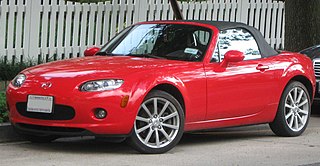
The Mazda MX-5 (NC) is the third generation of the Mazda MX-5 manufactured from 2005 to 2015. At its introduction in 2005, it won the Car of the Year Japan Award and made Car and Driver's 10Best list from 2006 to 2013. The NC is the first MX-5 generation to feature a retractable hardtop variant, with its roof being able to fold and unfold in 12 seconds without sacrificing trunk space.

The Mazda MX-5 (ND) is the fourth and current generation of the Mazda MX-5. Mazda officially unveiled the car on September 3, 2014 in the United States and Spain, and on September 4, 2014 in Japan. The new MX-5 was presented at the October 2014 Paris Motor Show, and at the November 2014 Los Angeles Auto Show. The car is manufactured in Mazda's Hiroshima plant. The vehicle was released in the third quarter of 2015. In the US, the release price of the MX-5 was between $24,915 and $30,065. On March 24, 2016 the MX-5 was awarded World Car of the Year (WCOTY) and the World Car Design of the Year at the New York Auto Show. It was the second Mazda to win WCOTY following the Demio/Mazda2 in 2008.
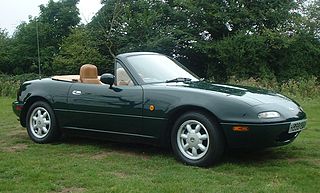
The Mazda MX-5 (NA) is the first generation of the Mazda MX-5 manufactured from 1989 to 1997. Inspired by the post-war era British sports cars, the MX-5 rejuvenated interest in roadsters after the demise of cars such as the MG B and Triumph Spitfire. Since its debut, the MX-5 has won numerous automotive awards and has become the world's best selling sports car.

The Mazda MX-5 (NB) is the second generation of the Mazda MX-5 manufactured from 1998 to 2005. The model continued the MX-5's philosophy of being a lightweight, front mid-engine, rear-wheel-drive roadster while featuring numerous performance improvements, however lacking its predecessor's retractable headlamps. The NB is also the only generation to feature a factory-built turbocharged variant in the form of the Mazdaspeed MX-5.
References
- ↑ "Forgotten cars of Australia: The Bullet Roadster". www.carsales.com.au. Retrieved 2020-03-08.
- ↑ "Australian-built roadster with blown Lexus V8 July 2001". web.archive.org. 2008-12-25. Retrieved 2020-03-08.
- ↑ "Web Wombat / Motoring / News & Reports / Bullet Roadster". m.webwombat.com.au. Retrieved 2020-03-08.
- ↑ "Bullet Cars History and Price Guide". Bullet Cars and 4WD - Australia’s Leading Supercharger Specialist. Retrieved 2020-03-08.
| This article about an automotive industry corporation or company is a stub. You can help Wikipedia by expanding it. |